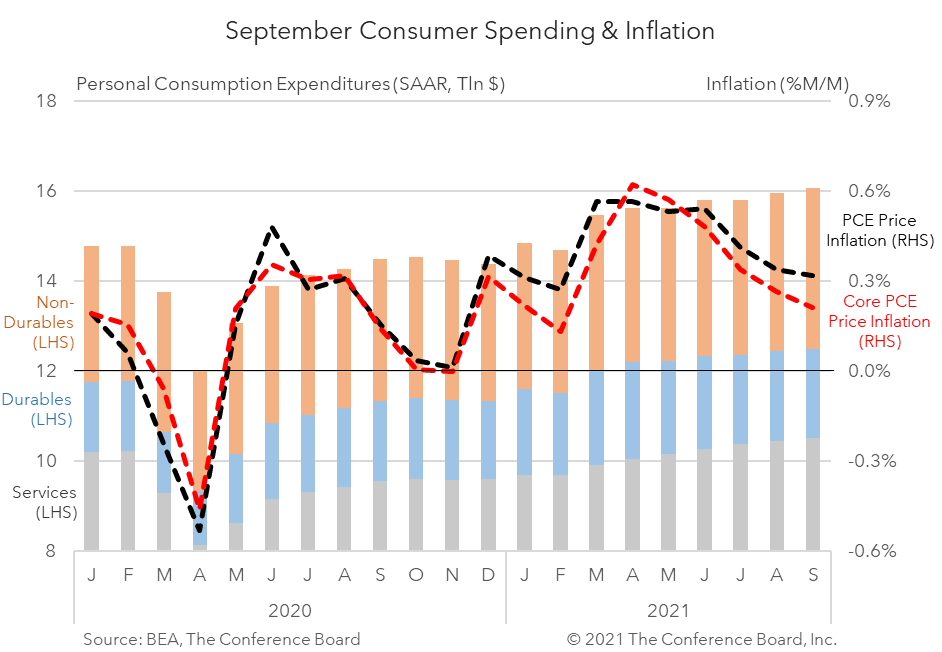-
Email
Linkedin
Facebook
Twitter
Copy Link

Loading...
September Personal Income & Outlays data, released this morning, show an economy emerging from the impact of the Delta variant. According to the Bureau of Economic Analysis (BEA), American incomes fell in September while consumer spending continued to expand. Inflation remained elevated, but the momentum of price increases moderated somewhat. Looking ahead, as the severity of the current wave of COVID-19 continues to ebb we expect consumer spending growth to accelerate, especially on in-person services. The expiration of some federal unemployment benefits in early September hurt personal income growth for the month, but a tight labor market should help incomes expand once again. While year-over-year (y/y) headline inflation remained at a 30 year high in September the month-over-month readings eased somewhat. Still, inflation readings will remain elevated until wage growth, supply chain disruptions, and excessive demand for some goods ease. Overall personal income fell 1.0 percent (in nominal terms) month-over-month (m/m) in September largely due to a sharp contraction in personal income transfer receipts associated with the expiration of some federal unemployment benefits. However, income attributed to employee compensation expanded by 0.7 percent – illustrating that working Americans are seeing their incomes continue to expand. This trend in employee compensation is likely to continue as more people rejoin the workforce and wage growth remains strong. Personal consumption expenditures rose 0.6 percent m/m in September following a 1.0 percent m/m increase in August. Spending on services rose by 0.6 percent m/m while spending on goods rose by 0.5 percent m/m. Meanwhile, spending on durable goods fell by 0.2 percent m/m while spending on non-durable goods rose by 0.9 percent m/m. In real terms, which accounts for inflation, consumer spending grew by 0.3 percent m/m in September with spending on services rising 0.4 percent m/m – a trend that provides positive momentum heading into Q4 2021. Headline PCE price inflation came in at a 30 year high of 4.4 percent year-over-year (y/y), vs. 4.2 percent y/y in August. The BEA also reported that Core PCE Inflation, excluding food and energy prices, was unchanged from the previous month at 3.6 percent y/y. Importantly, the month-over-month growth rates for these key inflation metrics both eased somewhat. Headline PCE inflation was 0.32 percent m/m in September, vs. 0.34 percent m/m in August and Core PCE inflation was 0.21 percent m/m in September, vs. 0.27 percent m/m in August. The primary inflation drivers in September were associated with food, fuel oil, and housing prices. However, prices gains among some former inflation drivers like new automobiles moderated or, in the case of transportation services, dropped. Excessive demand for some goods along with persistent supply side constraints underpin the current inflation trend.Comment on Personal Income & Outlays report for September

Retail Sales Show Consumers Stock Up ahead of Tariffs
April 16, 2025
US Seeks Shipbuilding Revival, Muting of China Dominance
April 14, 2025
March CPI May Hint at Consumer Pullback as Tariffs Rise
April 10, 2025
The US-China Trade War Escalates
April 09, 2025
Reciprocal Tariffs Will Weaken US and Global Economies
April 03, 2025
Charts
Consumer Confidence Declined for Second Consecutive Month in February
LEARN MORECharts
Omicron, Inflation, and Fed Dampen US Growth Prospects
LEARN MORECharts
Almost two years after the COVID-19 pandemic plunged the United States and the world into economic and social disruption, the nation is recovering.
LEARN MORECharts
High demand for labor is resulting in rapid hiring of the unemployed.
LEARN MORECharts
The Conference Board’s Salary Increase Budget Survey indicates that the average annual raise for current employees is accelerating.
LEARN MORECharts
The Conference Board Consumer Confidence Index® declined in November, following an increase in October. The Index now stands at 109.5 (1985=100), down from 111.
LEARN MORECharts
The Conference Board recently released its updated 2022 Global Economic Outlook.
LEARN MORECharts
America’s recent decline in global competitiveness raises concerns about the nation’s future economic stability and national security
LEARN MORECharts
Firms are struggling mightily to hire workers.
LEARN MORECharts
Crypto tokens--or cryptocurrencies---have a notional market value of more than $2.5 trillion today and are on pace to expand exponentially.
LEARN MOREFilter By Center
PRESS RELEASE
Global Productivity Growth Set to Disappoint Again in 2023
May 17, 2023
PRESS RELEASE
Stagnant Productivity Growth Returns
April 29, 2022
